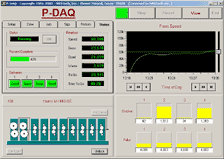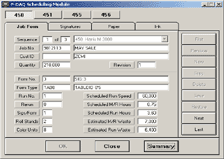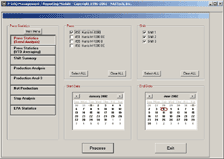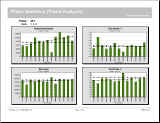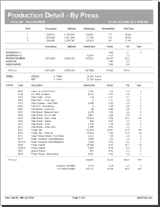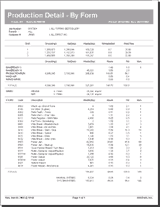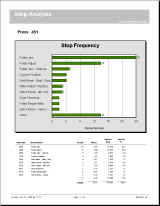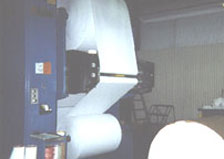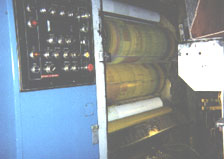 |
 |
| 1 | |

|
Systems
|
P-DAQ Press Management | |||||||||||
|
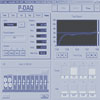 |
P-DAQ (pee' dak) is a sophisticated, graphical, touch-screen application that collects, analyzes, and reports on pressroom data that is necessary to manage the complexities involved with the printing process. P-DAQ represents the future of press management systems. It utilizes state of the art technology, a graphical user interface and electronic data acquisition while providing a completely open system architecture. P-DAQ consists of four primary modules, (click the links to the left for more information about each module) all operating together to provide the highest level of real-time data possible without compromising the fail-safe requirements of the system. Using our unique Bi-directional Data Synchronization Technology (BDST), the local and remote databases are continuously synchronized. P-DAQ monitors gross impressions, waste impressions, net count by signature, estimated time remaining, press performance, pallet production data, ink usage, paper consumption and much more all at the touch of a screen. P-DAQ can communicate with your current systems to facilitate the exchange of vital information throughout your business. P-DAQ can reduce the time spent in reporting labor and pallet information to other systems. A complete set of reports give users the information they need for trouble-shooting problems and analyzing productivity and performance. P-DAQ allows plant managers, scheduling personnel, and customer service representatives to monitor the current status of jobs from anywhere on the network with up to the minute data fed directly from the pressroom. P-DAQ collects and reports on data that print management has been asking for, but was previously too costly and time-consuming to acquire. KEY BENEFITS:
|
||||||||||
-------------------------------------------------------------------------------------------------------------------------------------------------
|
|
The Press Module collects real-time data from each press. The press is linked to the P-DAQ computer via the Press Interface Module (PIM). The pressman records labor and down-time reason codes. Waste, paper consumption and ink usage are also tracked. The Press Module main screen contains a header area and four sections. The View button provides access to the transaction logs, maintained by the system. The data is purged automatically after it has been transferred to the file server based upon predefined purge criteria. The upper left quadrant contains a series of folders used to define the configuration of the press, to define the crew for each shift, to define the job specifications and to view the status of the press. The upper right quadrant contains press speed statistics for the past 24-hour period. The scheduled running speed of the press is also displayed. Press stops may be easily located using the chart. The bottom left quadrant represents the current configuration of the press. The graphic represents the maximum configuration of the press with grayed areas used to represent the roll stands and/or color units not being utilized for the current form. The bottom right quadrant represents the current delivery configuration of the press. The graphic represents the maximum configuration of the press with grayed areas used to represent the deliveries not being utilized for the current run.
|
|
|
The Shift Log is used to record activities performed on each shift. Entries are made to the shift log automatically whenever an event occurs. The events recorded are as follows:
|
-------------------------------------------------------------------------------------------------------------------------------------------------
|
|
The Scheduling Module is used to define or view the requirements of scheduled jobs prior to going to press. Entering jobs here and not at the press, simplifies the flow of work to the pressroom, and allows operators to focus on the operation of the press. At the press, jobs are selected simply with a touch of a screen. The
flexibility of the system enables jobs to be loaded from in-house
scheduling systems. Once loaded, jobs can be easily moved from press to press and can easily be re-ordered when priorities change. |
-------------------------------------------------------------------------------------------------------------------------------------------------
|
|
The Press Status Module is used by customer service, scheduling and management personnel to determine the current status of jobs on press. The folder tabs represent the presses which may be viewed. Once selected, the current status is displayed.The status is then updated approximately every 15 seconds. Time remaining is calculated and displayed based on current and average press speeds.The time remaining based on the average speed is valuable if the press is down. Taking advantage of the latest technology, the Press Status Module also allows management and/or your customers to view job status information from virtually anywhere in the world via the internet. |
|
|
|
Using the Status Summary screen, the status of all presses may be viewed simultaneously. This allows you to view the status of the entire pressroom at a glance. |
-------------------------------------------------------------------------------------------------------------------------------------------------
|
|
The
Reporting Module
is used by management to access the vast amount of data accumulated
by the system. Reports can be viewed or printed based on specified
selection criteria. Once the report is displayed, it may be printed
selectively or in its entirety. The reporting system provides a valuable
tool for cutting costs and for evaluating press and crew performance.
The system currently contains more than 70 reports. They are grouped as follows:
The
following shows and explains some of the reports in more detail and
displays some of the charts provided: |
|
|
|
The Press Statistics Report shows press statistical information summarized by week for a specified period. The statistical detail for the charted data is provided on a separate page. The charts produced are as follows:
|
|
|
|
Production Detail by Press is used to view detailed statistics for each press and includes stops associated with the press. | |
|
|
Production Detail by Form is used to view detailed statistics for each form and includes stops associated with the form. | |
|
|
The
Stop Analysis Reports are used to analyze press stops based on
several different criteria. While measuring down-time and waste is important,
the main objective should be to reduce waste. These reports provide
an invaluable tool for waste reduction. Several charts are produced
which rank the reasons for the stops as follows: Top
10 causes based on stop frequency. |
-------------------------------------------------------------------------------------------------------------------------------------------------
|
|
The Paper Management Module is used to track paper consumption. Paper usage is tracked by job, by press, by shift, and by crew. A comprehensive set of reports are used to analyze paper usage on a job and form basis, and to analyze paper usage by mill.
|
-------------------------------------------------------------------------------------------------------------------------------------------------
|
|
The Ink Tracking Module is used to track ink consumption. The system works in conjunction with sophisticated ink metering devices. Ink usage is tracked by job, by press, by shift, and by crew. A comprehensive set of reports are used to analyze ink usage on a job and form basis.
|
| © Copyright 2003 - 2013 NASTech, Inc | |||||

